|
Regarded as the greatest singer-songwriter in country
music's history, Hank Williams consistently crossed over
into pop music with heartfelt songs such as "Your Cheating
Heart", "Cold, Cold Heart" and "I'm
So Lonesome I Could Cry". Sadly Hank Williams died
over 50 years ago at the age of twenty-nine years in the back
seat of his Cadillac on New Years Day 1953.
Misspelled "Hiriam" on his birth certificate,
Hiram Williams was born in Mount Olive West, Alabama on
17th September 1923. Growing up in abject poverty in a clapboard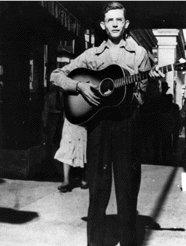 house; he had an absentee father (Lonnie) and a domineering
mother (Lilly) and started singing in the Mount Olive Baptist
Church at six where his mother played the organ. In 1930
Lonnie entered the VA hospital in Alexandria and Lilly moved
Hiram and his sister Irene from the country to Georgiana.
After a fire burnt-down the shack where they lived, Lilly
rented a furnished room in Greenville. Irene roasted which
Hiriam sold on the streets and along with shining shoes
for a nickel a time Hank made a little money to buy food
for the family. Lilly found a bigger house and decided to
open a boarding house about a hundred yards from the railroad
tracks and the clatter of the big Pan American became a
welcome sound. The young Hiram hated his name and stated
calling himself Hank. At birth Hank had a crippling birth
defect of the lower spine, which was aggravated when a bronc
threw Hank while working as a cowboy in Texas, causing injury
to his back that was to plaque him for the rest of his life.
house; he had an absentee father (Lonnie) and a domineering
mother (Lilly) and started singing in the Mount Olive Baptist
Church at six where his mother played the organ. In 1930
Lonnie entered the VA hospital in Alexandria and Lilly moved
Hiram and his sister Irene from the country to Georgiana.
After a fire burnt-down the shack where they lived, Lilly
rented a furnished room in Greenville. Irene roasted which
Hiriam sold on the streets and along with shining shoes
for a nickel a time Hank made a little money to buy food
for the family. Lilly found a bigger house and decided to
open a boarding house about a hundred yards from the railroad
tracks and the clatter of the big Pan American became a
welcome sound. The young Hiram hated his name and stated
calling himself Hank. At birth Hank had a crippling birth
defect of the lower spine, which was aggravated when a bronc
threw Hank while working as a cowboy in Texas, causing injury
to his back that was to plaque him for the rest of his life.
Lilly bought Hank a second-hand Silvertone guitar for
$3-50, which she paid off at 50 cents a month. Hank started
taking lessons from an elderly black street musician known
by the name of Tee-Tot (Rufus Payne). Hank stated singing
with Tee-Tot on the streets of Greenville and the courthouse
lawn on a Saturday when the farmers came into town and people
started calling them the "Greenville Troubadours".
As well as learning to play guitar, Hiram also learnt from
Tee-Tot how to work a crowd. As young Hiram progressed,
Tee-Tot taught him what he called his "bestest"
song..."My Bucket's Got A Hole In It" was later
to be copyrighted by Hank Williams and published in the
Acuff-Rose catalogue.
Lilly's main concern was status and money and said Hank
was "wasting his time lollygagging around town with
that guitar and that nigger and woolgathering around  the
house listening to hillbilly singers on the radio."
"He would never make anything of himself that way"
she lectured him. Hank got pretty hot under the collar telling
his mother, "That maybe he had already decided to become
a hillbilly singer and there wasn't a gol-durned thing wrong
with that. He continued, "Hillbilly singers got to
be on the radio and travel and own big cars and fancy suits." the
house listening to hillbilly singers on the radio."
"He would never make anything of himself that way"
she lectured him. Hank got pretty hot under the collar telling
his mother, "That maybe he had already decided to become
a hillbilly singer and there wasn't a gol-durned thing wrong
with that. He continued, "Hillbilly singers got to
be on the radio and travel and own big cars and fancy suits."
Things weren't working out as Lilly had hoped in Greenville
and moved her brood to Montgomery in 1937, starting another
boarding house. Barley into his teens, Hank Williams entered
a Christmas talent contest and won $15 singing an original
song "WPA Blues". In the wake of his first public
appearance Lilly shocked Hank by telling him she was proud
of him and even bought him a new Gibson guitar. Hank started
playing with Smith "Hezzy" Adair calling themselves
Hezzy and Hank, which within a few weeks had changed to
Hank and Hezzy. Soon after, Braxton Schuffert joined the
pair forming the band The Drifting Cowboys with Hank on
guitar and vocals, Hezzy on bass, Braxton on guitar and
vocals, Freddy Beech on fiddle and Irene Williams on vocals
and ticket-taker. Very soon they were playing on radio station
WSFA's Saturday Night Jamboree in Montgomery, followed by
a twice-weekly show on WCOV. When Hank got his own show
on WSFA the fan mail came rolling in. It was time for  Hank
to start playing show dates and as Schuffert had a car,
they loaded it up and headed out to play dances and parties.
The Drifting Cowboys soon graduated to playing honky-tonks
and dances at Thigpen's Log Cabin, north of Georgiana, where
the working man could let off steam and wanted to listen
to raucous dance music such as "Honky Tonk Blues"
and "Headin' Down The Wrong Highway." Hank
to start playing show dates and as Schuffert had a car,
they loaded it up and headed out to play dances and parties.
The Drifting Cowboys soon graduated to playing honky-tonks
and dances at Thigpen's Log Cabin, north of Georgiana, where
the working man could let off steam and wanted to listen
to raucous dance music such as "Honky Tonk Blues"
and "Headin' Down The Wrong Highway."
Hank was eighteen years old when World War II broke
out. He was rejected for military service due to his bad
back. Hank continued playing the honky-tonks, always handing
his money over to Lilly, though he held on to a little so
that he could get drunk and get himself a woman. After a
fight with Lilly, Hank took the few dollars he had and set
off for Mobile, Alabama hoping to go to sea. Unfortunately
he never got out to sea. Feeling sad and lonely Hank started
thinking about a woman he had got to know while playing
at a medicine show in Pike County...Miss Audrey!!!
Audrey Sheppard had already been married and had a daughter
by the name of Lycrecia. Hank was "Hot" for Audrey...another
tempestuous woman who drove Hank 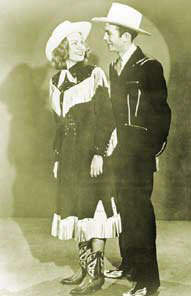 with
a driving ambition for herself as well as Hank. They set
up home together and in December 1944 Audrey and Hank were
married at a filling station by Justice of the Peace M.
A. Boyett in Alabama. In the meantime Hank's mother Lilly
was busy booking dates for Hank, with 60 days solid in the
date book. Lilly travelled to Mobil and when Hank saw the
date book he crawled back to Montgomery with Lilly and re-formed
the Drifting Cowboys, which included Audrey. As Hank's career
blossomed, Audrey wanted a greater part of the limelight.
Though she couldn't sing, Audrey insisted that she had equal
stage time and even wanted to co-write his songs, with the
likes of "My Darling Baby Girl", written about
Audrey's daughter Lycrecia. with
a driving ambition for herself as well as Hank. They set
up home together and in December 1944 Audrey and Hank were
married at a filling station by Justice of the Peace M.
A. Boyett in Alabama. In the meantime Hank's mother Lilly
was busy booking dates for Hank, with 60 days solid in the
date book. Lilly travelled to Mobil and when Hank saw the
date book he crawled back to Montgomery with Lilly and re-formed
the Drifting Cowboys, which included Audrey. As Hank's career
blossomed, Audrey wanted a greater part of the limelight.
Though she couldn't sing, Audrey insisted that she had equal
stage time and even wanted to co-write his songs, with the
likes of "My Darling Baby Girl", written about
Audrey's daughter Lycrecia.
In 1946 Hank signed with Sterling Records. Taking a
trip to Nashville with Audrey, Fred Rose of the Acuff-Rose
publishing house was so impressed with Hank, that he became
his manager and instrumental in getting Hank a more prestigious
recording contract with the new MGM in 1947. Hank's first
release with MGM was "Move It On Over", selling
several thousand copies. In 1948 Hank joined the popular
radio show, Louisiana Hayride and then became a regular
on The Grand Ol' Opry on 11th June 1949 resulting in six
demanding encores of 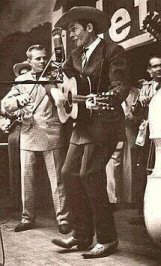 "Lovesick
Blues"…a first in the Opry history. "Lovesick
Blues" was originally recorded by Emmett Miller in
1925 and then by Rex Griffin in 1939, but Hank's recording
went straight to the top of the country charts, staying
there for 16 weeks and remaining on the list for the rest
of the year. Hank was the hottest property in town, dominating
both the country and pop charts. In 1950 "Wedding Bells"
made #2 as did "I'm So Lonesome I Could Cry",
backed with "My Bucket's Got A Hole In It". Three
number 1 hits saw "Long Gone Lonesome Blues",
"Why Don't You Love me" and "Moanin' The
Blues". 1951 saw "Cold, Cold Heart" and "Hey
Good Lookin" topping the charts and the double sided
"Howlin At The Moon"/"I Can't Help It (If
I'm Still In Love With You)" made #2. The following
year Hank made #1 with the Cajun styled "Jambalaya"
and "Half As Much" made #2 as did the double sided
"Settin' The Woods On Fire"/"You Win Again". "Lovesick
Blues"…a first in the Opry history. "Lovesick
Blues" was originally recorded by Emmett Miller in
1925 and then by Rex Griffin in 1939, but Hank's recording
went straight to the top of the country charts, staying
there for 16 weeks and remaining on the list for the rest
of the year. Hank was the hottest property in town, dominating
both the country and pop charts. In 1950 "Wedding Bells"
made #2 as did "I'm So Lonesome I Could Cry",
backed with "My Bucket's Got A Hole In It". Three
number 1 hits saw "Long Gone Lonesome Blues",
"Why Don't You Love me" and "Moanin' The
Blues". 1951 saw "Cold, Cold Heart" and "Hey
Good Lookin" topping the charts and the double sided
"Howlin At The Moon"/"I Can't Help It (If
I'm Still In Love With You)" made #2. The following
year Hank made #1 with the Cajun styled "Jambalaya"
and "Half As Much" made #2 as did the double sided
"Settin' The Woods On Fire"/"You Win Again".
Hank also recorded Saturday night sin songs under the
alter ego "Luke The Drifter", including "Beyond
The Sunset", "Pictures from The Other side Of
Life" and "Too Many Parties and Too Many Pals".
Audrey also had an attempt at a solo 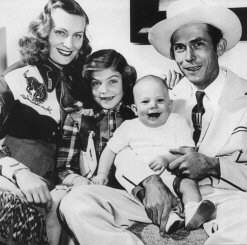 recording,
which was a non-starter from the beginning as her singing
talent was virtually non-existent. Hank and Audrey had a
son Hank Williams Jnr (fondly known as Bocephus) born on
26th May 1949. The two were divorced on 19th May 1952, with
Audrey receiving one-half of Hank's future royalties. Due
to Hank's heavy drinking he was fired from the Opry in August
1952 and returned to the Louisiana Hayride. On 19th October
1952 Hank married teenaged Billie Jean Jones - three times.
First before a Justice of the Peace in Minden, Louisiana,
then at two concerts at New Orleans, before thousands of
paying guests. By this time Hank's career was in a shambles,
due to his drinking and pill popping causing him to miss
several dates. recording,
which was a non-starter from the beginning as her singing
talent was virtually non-existent. Hank and Audrey had a
son Hank Williams Jnr (fondly known as Bocephus) born on
26th May 1949. The two were divorced on 19th May 1952, with
Audrey receiving one-half of Hank's future royalties. Due
to Hank's heavy drinking he was fired from the Opry in August
1952 and returned to the Louisiana Hayride. On 19th October
1952 Hank married teenaged Billie Jean Jones - three times.
First before a Justice of the Peace in Minden, Louisiana,
then at two concerts at New Orleans, before thousands of
paying guests. By this time Hank's career was in a shambles,
due to his drinking and pill popping causing him to miss
several dates.
Hank's biggest booking for some time was to be on New
Year's Day 1953 at Canton, Ohio. Also on the bill were Hawkshaw
Hawkins and Homer & Jethro. Due to a blizzard Hank William's
plane was cancelled and he booked into a hotel at Knoxville.
Hank had not been feeling well and the desk clerk called
a doctor who gave Hank two morphine injections. An18-year-old
taxi driver by the name of Charles Carr had been hired to
drive Hank to the gig in Hank's own Cadillac. Hank was barely
conscious and was loaded into the back seat. Nursing a bottle
of vodka Hank woke-up and washed down a chloral hydrate
tablet. En-route Highway Patrolmen Swann Kitts pulled Carr
over for speeding near Rutledge, Tennessee. Looking at Hank
in the back of the car, he casually commented, "hey
that guy looks dead." Carr said that he was just sedated
and after paying the $25 fine he drove on. At around 5:30
am Carr stopped at a gas station in Oak Hill, West Virginia
to ask directions. 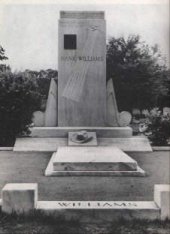 Hank
was very still, slumped in the back of the car. Carr found
him cold to the touch and went to get help. Patrolman Howard
Jamey was summoned and found that Hank was dead. He drove
the Cadillac to Oak Hill Hospital where Hank was confirmed
Dead On Arrival at the age of 29 years. Hank
was very still, slumped in the back of the car. Carr found
him cold to the touch and went to get help. Patrolman Howard
Jamey was summoned and found that Hank was dead. He drove
the Cadillac to Oak Hill Hospital where Hank was confirmed
Dead On Arrival at the age of 29 years.
Hank's funeral took place in Montgomery attended by
20,000 mourners. Earnest Tubb sang "Close To The Lord",
Red Foley sang "Peace In The Valley" and Roy Acuff
sang "I Saw The Light". The irony of it all was
that Hank's single "I'll Never Get Out Of This World
Alive" had just been released and within weeks was
riding high in the charts. Within months of his death, other
hits included "Your Cheatin' Heart", "Take
These Chains From My Heart", "I Won't Be Home
No More" and "Weary Blue From Waitin". Hank
was elected into the Country Music Hall Of Fame in 1961
and actor George Hamilton portrayed Hank in the 1965 movie
Your Cheatin' Heart, with the soundtrack dubbed by Hank
Williams Jnr.
2005 in Oak Hill, West Virginia, locals hope to turn
an old Pure Oil service station into a museum to honour Hank
Williams. The city of Oak Hill plans to hold a
lease on the proposed museum property until it can be turned
over to a foundation.
In the summer of 2002 Hank Williams' gravesite was vandalized.
A large marble vase was stolen from the site according to
the Tuscaloosa News. The vase, made of Georgia marble and
engraved with the initials H.W., was stationed at the grave
of Williams' and an ex-wife, Audrey. It wasn't the first
time the vase had been stolen. Someone took it about three
years ago, but the vase found undamaged shortly after. Said
Beth Birtley, manager of the Hank 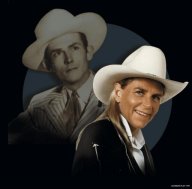 Williams
Museum, "We don't want to prosecute. We don't have
to know who took it. We just want it back". Hank Williams
is buried in the Oakwood Annex in Montgomery, Alabama. Williams
Museum, "We don't want to prosecute. We don't have
to know who took it. We just want it back". Hank Williams
is buried in the Oakwood Annex in Montgomery, Alabama.
Hank was the biggest innovator of country music. He
recorded 166 songs between 1946-52 and has drawn tribute
records from a host of country singers. Hank's songwriting
contained a lot of pain; he made a great contribution to
country music, influencing many generations of country singers
who followed in his wake. As we revere this man, he continues
to be a legend in our time.
A postscript comes with claims from an illegitimate
daughter Jett Williams, who was born three days after Hank's
death. The claim by the daughter of country singer Bobbie
Jett was upheld after a bitter court case took place for
her to be recognised as a daughter of Hank Williams….but
that is another story!!!!
Check out my book review of Ain't
Nothin' as Sweet as My Baby The
Story of Hank Williams' Lost Daughter
|


![]()